Original Photo: Sandy Lee
When Bill Tilman was lost in the stormy South Atlantic seas in 1977, with the entire crew of the the En Avant, en route to Smith Island, where several of the crew intended to launch a mountaineering expedition, the world lost a remarkable adventurer and irrepressible free spirit. In his 80th year, an age when most people-even those with a climbing and sailing background-have gracefully retired from the activity and content themselves with books and gardening, Tilman found it impossible to let go of the reins. Pushing his elderly body as far as possible. Never for one moment entertaining the possibility that he could not still play a hand’s on roll on an expedition.
Now Vertebrate Publishing-best known as one of the UK’s premier mountaineering book publishers, have teamed up with sailing publishing house, Lodestar Books- to bring Tilman’s adventure books back into the spotlight. With over half of the reprint run already in the bookshops, its a good time for those unfamiliar with this fascinating and iconic figure from the world of mountaineering and ocean sailing, to acquaint themselves with the Tilman oeuvre.
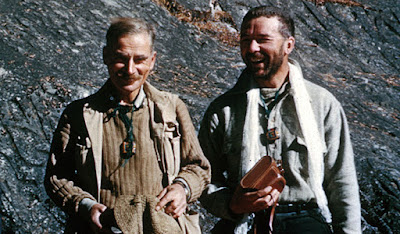
Born at the very end of the 19th century, just as Queen Victoria was leaving the stage, the Merseysider who was born in Wallasey on the Wirral was the son of a successful sugar merchant. Tilman would have looked out to the Liverpool docks across the busy waterway, where he would see the commodity which funded his somewhat privileged life, unloaded into the great warehouses which lined the then thriving Liverpool docklands. Perhaps it was being born at the mouth of a great river which stimulated an interest in all things nautical?
Sent off for a private education at Berkhamstead, after completing his education, the young Tilman soon found himself caught up in the carnage of the first world war. Surviving amongst other campaigns, the battle of the Somme. Ten years after the war, Tilman met up with Eric Shipton who like himself was engaged in the coffee trade of East Africa. Early forays upon Mount Kenya, Kilimanjaro and Ruwenzori cemented a highly successful and long lasting climbing partnership.
Between the wars,Tilman was involved in two of the 1930s Mount Everest expeditions. The 1935 Reconnaissance Expedition, and as leader of the 1938 expedition when he reached 27200 feet without oxygen. With Shipton, he ventured into the previously unexplored Nanda Devi sanctuary in 1934 and two years later he returned and led a UK/US expedition which mounted a successful attempt on the summit. A mountain which until 1950, remained the highest yet climbed.

Despite his age, Tillman volunteered for service in the WW2 and served in North Africa and Dunkirk. Later in the campaign he saw action behind enemy lines and fought with Albanian and Italian partisans in their bloody campaign in southern Europe and was awarded the DSO for his sterling work with the partisans.
After the war and now approaching his 50‘s, he began an impressive ocean sailing career to which complimented his mountaineering activities by enabling him to visit far flung and previously inaccessible areas. Initially setting sail in his famous Pilot Cutter ‘Mischief’ and visiting the Arctic regions and several remote Atlantic and Pacific islands, Tilman went on to skipper two more pilot cutters; ‘Sea Breeze’ and ‘Baroque’, before setting out on his fateful final voyage as a crew member of the Simon Richardson skippered ‘En Avant’.
With regard to the ill fated vessel, its worth quoting from a Yachting and Boating forum where a contributor’s diligent research had turned up the following information.....
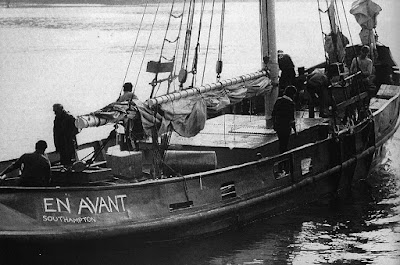
“En Avant was a wartime tugboat hull constructed by slave labour. She was a semi-wreck and had been sunk more than once, Richardson himself fitted a Deutz marine engine, large battery banks and a welded keel. She had good stability but low freeboard. There have been differing views of the boat, Colin Putt wrote: "En Avant proved to be a good sea boat and the crew turned up trumps" elsewhere she was described as a "sorry sight" and was thought to be unsuitable for the trip. Conditions on board would have been stark.
I suspect the trip was funded by Richardson's own resources perhaps with contributions from the crew. He bought the boat for £750 and was given the engine. He was keen on Tilman's concept of small, low cost, expeditions. His Mother's writings (which I have not seen) would no doubt flesh this out.....There were seven on the trip: Tilman, Richardson, Coatman, Toombs, Williams (contacted by advert), Johnson (old school friend) and Dittamore (American Climber)....I guess some of the three brought in by advert would be sailors.’.

Bill Tilman spent the last 30 years of his life here in North Wales.Living in the beautifully situated traditional stone country house of Bod Owen, above the Malltraeth Estuary near Barmouth in Gwynedd.Ironically, a quiet and peaceful stretch of water compared to the incomparably wild and stormy waters of the South Atlantic which took his life.
The Adventure Archive..
1929: Tilman is introduced to rock climbing in the Lake District of England.
1930: He ascends Mawenzi and almost ascends Kibo on Kilimanjaro, with Eric Shipton.
1930: He makes first ascent of West Ridge of Batian, and traverses to Nelion, with Shipton.
1932: Tilman ascends Mounts Speke, Baker, and Stanley in the Ruwenzori Range, with Shipton.
1932: In April, he is involved in an accident in the Lake District which leads to the death of J. S. Brogdon.
1932: Later that year, he makes various climbs in the Alps.
1933: Tilman ascends Kilimanjaro (to summit) alone.
1934: Tilman and Shipton, with three others, make the first recorded
entrance into the Nanda Devi Sanctuary. They also explore the nearby
Badrinath Range.
1935: Tilman unable to acclimatise on the Mount Everest
Reconnaissance Expedition led by Eric Shipton, but climbs various
20,000 ft. peaks in the Everest region.
1936: Tilman attempts various peaks and passes, including the Zemu
Gap, in Sikkim, near Kangchenjunga. Later, he leads the first ascent of
Nanda Devi.
1937: Shipton and Tilman make a major reconnaissance and surveying expedition in the Karakoram.
1938: Tilman leads another Mount Everest Expedition; he and three others reach above 27,300 ft (8,320 m) but fail to reach the summit.
1938: He traverses the Zemu Gap.
1939: He leads an expedition in the remote Assam Himalaya, which
ends in disaster. They attempt Gori Chen, but reach only the lower
slopes. The party was ravaged by Malaria, causing the death of one
member.
1941: Tilman climbs various peaks in Kurdistan.
1942: He makes a night ascent of Zaghouan, in Tunisia.
1947: Tilman leads an attempt on Rakaposhi which explores five
different routes, none of which get near the summit. The expedition then
explored the Kukuay Glacier on the southwest side of the Batura
Muztagh.
1947: He attempts Muztagh Ata, with Shipton and Gyalgen Sherpa.
1948: Tilman attempts Bogda Feng, in northern Xinjiang, with Shipton and two others, but they only reach outlying summits.
1948: He attempts Chakragil, in western Xinjiang.
1948: He travels in the Chitral area of the Hindu Kush.
1949: Tilman leads a four-month exploratory and scientific
expedition to the Langtang, Ganesh, and Jugal Himals in Nepal, in the
early stages of that country's re-opening to outsiders. He climbs Paldor
in the Ganesh Himal.
1950: He leads the British Annapurna Expedition, which gets close to
the summit of Annapurna IV, and attempts other nearby peaks.
1950: Tilman and Charles Houston view Mount Everest from the lower
slopes of Pumori, on the recently opened Nepalese side of the peak.
1955 – 12 months, 20,000 miles: First voyage in Mischief. Together with Jorge Quinteros he performs the first longitudinal crossing of the Southern Patagonian Ice Field.
1957 – 12 months, 21,000 miles, circumnavigation of the African continent
1959 – 12 months, 20,000 miles, South Atlantic, Iles Crozet
1961 – 4 months, 7,500 miles, West Greenland - Upernavik region
1962 – 4 months, 6,500 miles, West Greenland and Baffin Island
1963 – 4 months, 7,000 miles, Bylot Island, Baffin Bay
1964 – 4 months, 3,700 miles, East Greenland
1964 – 5 months, 10,000 miles, skippering the schooner Patanela to Heard Island in the Southern Ocean
1965 – 4 months, 4,000 miles, East Greenland - Return visit
1966 – 12 months, 20,400 miles, Islands of the Southern Ocean
1968 – 3 months, 2,500 miles, East Greenland, Jan Mayen, Loss of Mischief
1969 – 4 months, 3,400 miles, first voyage in Sea Breeze - East Greenland
1970 – 4 months, 5,000 miles, South West Greenland - Faeringehavn, Julianhaab, Nanortalik, Torsukatak
1971 – 4 months, 5,000 miles, Faroe Islands, Iceland, East Greenland - Angmassalik
1972 – 3 months, 3,000 miles, East Greenland, Loss of Sea Breeze
1973 – 4 months, 5,000 miles, First voyage in Baroque, to West Greenland.
1974 – 4 months, 7,000 miles, circumnavigation of Spitzbergen
1975 – 4 months, 5,000 miles, West Greenland
1976 – 4 months, East Greenland - Angmagssalik - Reykjavik
1977 - 1 month, Reykjavik-Lymington
1977 – 4 months (?), Carried as crew/navigator on Simon Richardson's En Avant
from Southampton to Las Palmas then Rio de Janeiro. Vessel presumed
lost at sea on route to the Falkland Islands with loss of all hands.
Source WikiPedia
John Appleby:2016
The Tilman Series of adventure books are available from Vertebrate Publishers.
Tilman Archive: Yachting and Boating forum

I suppose a solid week of rain and gales can make even the most hardened of the rain dancing pub dwellers wish for a bit of sunshine. If only in order to remain dry between car and bar. After all, it is possible to spend an entire day in the Old Dungeon Ghyll starting in the snacks and soft drinks end at 9 a.m. (does anyone really crawl out of their tent that early) moving to the bar at the stroke of eleven and back to the snacks for the brief respite from 3.10 till 5 p.m. After a week of these conditions, Friday morning produced some change in that it managed to rain even harder and we were on the verge of becoming totally insane, irretrievably alcoholic, or both. Something had to be done rain or not. Leaving the bar shortly after midday (after all we do have to pay our respects to the brewery) amid the usual flurry of ribald and colourful remarks, we headed for Stool End just as the downpour turned on an extra violent display.
One or two well waterproofed early risers looked a little surprised to see anyone starting up the hill at that late hour (for them anyway) especially after a morning during which conditions had degenerated from worse to much worse. Nevertheless we were greeted cheerily, no doubt because they were on their way to dry warm surroundings such as we had recently vacated. Rick set a cracking pace up the Band and it was not long before I cracked and allowed the gap between us to widen, settling down to a steady, head down plod, which allowed the rain to drip from my cagoule hood to the ground instead of coursing down my nose and eventually trickling down my neck. By the time we turned off the main path to head for the Climbers' Traverse he was almost out of sight and soon disappeared over the ridge. I stopped briefly to see what it felt like not to be heaving for breath, then struggled on to reach the high point. Sensing relief at the thought that the next section was more or less level. No sign of Rick. Another brief respite, then making a much better pace I managed to catch him as he stopped to examine the dripping walls of Flat Crags.
Bowfell Buttress itself was by turns hidden or visible as banks of cloud swirled up and down the gullies and cascaded over the top like a silent, ghostly waterfall. And still it rained. Once ,at the foot, we exposed the ropes and assorted gear to the elements and made haste to get started before we had time to cool off. My one previous acquaintance with Bowfell Buttress had been in glorious weather four years previously and I had climbed, unethically I feel, in PA’s. This time Rick was in a pair of very bendy army type boots- of dubious origin- matched by my worn out, loose soled ‘leakies’. Both in full waterproofs (at least, that's what equipment dealers sell them as) and carrying sacs with us. All we needed were Alpenstocks and Edward Whymper would have been proud of us.

As I was tied to the rope ends which came from the top of the now soggy heaps, I took first lead up what should have been easy rock to the foot of the chimney. Every reach upwards produced an uncomfortable trickle down the sleeve of my Kag and every flat or slightly hollowed hold contained a puddle which froze the fingers and improved the flow of water down my arms. The footholds could be likened to miniature skating rinks so it was some relief to find the chimney relatively dry. "I'll carry on Rick," I said, dropping a tape runner over a large block. His face was a study of wet, cold misery, huddled at the foot, paying out soggy rope through frozen fingers. I moved up, jammed myself in and struggled, gaining height by inches rather than feet. The exit right at the top proved extremely awkward since I was unable to reach a large hold, and every time I moved up, my sac jammed under the overhang at the top of the left wall.
Five minutes later more squirming and heaving had generated considerable warmth and enough progress to allow a step right, then up to the large terrace. And once more into the driving rain. "Alright whose silly idea was this anyway?" A "Thank Gawd" look spread across Rick's face as I called for him to climb. He made short work of the first bit and used his height and reach advantage to make the chimney look easy before accepting some ironmongery for use on the next pitch. I watched with growing apprehension as Rick normally leads several standards above mine and was spending some time making moves up the first steep wall. Eventually he disappeared around a corner on the left and seemed, to be climbing steadily. Occasionally the chink and click of karabiners drifted down through the rain and mist till I soon called that there was only ten feet of rope left. No reply. A lung splitting shout prompted an answer, rather muffled, but to the effect that he was about to belay.
I had to assume that the next call from above as the rope tightened meant that I could start and quickly discovered why the little wall had proved awkward. Two steps up on sloping wet foot holds with nothing much for the hands, followed by a tricky move right to a small ledge then better holds to traverse up to the left and round the corner into an open chimney-groove cum watercourse. A doddle in P.A.s but in these conditions it took me some time to reach the comparative security of the watercourse. Thirty feet of this led to a large runner and the rope vanishing round to the right over easy ground. ,Rick was belayed at the bottom of a vertical, ten foot crack that formed the start of the next pitch. I studied it, unconvinced of my ability to lead in the prevailing conditions. Two attempts were enough and I more or less slid back down. Hanging on to the sling from a chock jammed high in the crack as part of the belay.
"We'll be here all day if I keep at this," I said, "you have a go." Gear was exchanged and in a matter of minutes Rick once again vanished from view. With only a few feet of rope left movement ceased. A moment or two of delay then a voice from the clouds, "Right, when you're ready." Confidence in the top rope improved the appearance of the crack no end and in spite of one boot sliding from a greasy foothold, I was soon up and following the rope away to the left. This proved to be the wrong line, forcing me into a difficult and slippery step round on to a sloping ledge to regain the route. Easy climbing from here led to a short wall with a Chimney in the corner to its left. I ascended the wall on good holds to a narrow ledge which ended some feet from the Chimney from where the step across looked decidedly nasty.
A very long, blind, off balance stride to a slimy unseen foothold. Easy in the dry but with rain still bucketing down-and in bendy boots- quite intimidating. I was glad to have avoided leading that. Sixty easy feet to go, I accepted the sharp end and made quick work of yet another chimney and easy groove that trended to the left and easy ground. As Rick arrived the heavens decided on a final fling and pelted us with fair sized hailstones for some minutes before easing away to nothing. Just another bit of amusement for us as we coiled the ropes. "Oh for a pint !" Scrambling to the top of the ridge we were rewarded for our efforts by a remarkable sight. The clouds had lifted and were scudding just above the top of Bowfell on our left and looking underneath them towards the coast, we could see the line where they ended abruptly. Brilliant sunshine produced an intense silvery reflection from a sea darkened by scattered cloud showers near the shore but quite clear and tending to become almost golden further out. In the distance, the shadowy hump of The Isle of Man stood out beneath the final ridge of Scafell.

Image: The Old Dungeon Ghyll
What a superb way to finish a climb we thought. As we walked over Bowfell summit and down towards the Band, the rain ceased completely and a patch of blue widened above us. "Well," Said Rick, "I think that's done it, we've frightened the weather off." And indeed we had. Saturday and Sunday provided us with two excellent days climbing. But that's another story before which we had an appointment with a pint glass and some dry clothing. A worthwhile day? Yes definitely. Under these conditions Bowfell Buttress gets my five star rating for a fine mountaineering route.
Tony Sainsbury: First published as 'A Worthwhile Day'in Climber and Rambler-September 1977

Ever since the mountain was first attacked in 1922 Everest has taken its toll of human lives. Of course everyone interested in the history of Himalayan climbing knows that the summit bid made by Mallory and Irvine on June 8th 1924 ended in disaster. I should expect an educated young climber to be able to tell me something about Mallory: I should be astonished if any information were forthcoming about Irvine. Not so now that the Irvine diaries and his biography have been published. Before it would hardly have been wrong to call Irvine "the unknown Everester". Now on Everest's roll of honour he can occupy the place he deserves. With hindsight one can see that the years between 1919 and 1925 were not the best of times to launch attempts to climb Everest.The climbing world of those days was very small and the number of experienced mountaineers of the right age had been heavily cut down by the blood bath of the 1914-18 war.
Passages by sea made it necessary for a man to get leave of six to eight months from his home and many ‘possibles’ could not do this, nor could they have afforded it had the leave been given. Thus the 1924 expedition started out with only eight climbers....in 1953 there were 14. about high altitude climbing we then had almost everything to learn; as an example, i remember Captain Farrah saying to me in 1920 that he thought that four climbers on an expedition would be a big enough team to make an effective dash for the top.
One had to admit that the pioneer climbs on Everest had two major results. first,they set foot on great controversy about the use of oxygen on high altitude climbs. At first, most mountaineers were against it. this certainly applies to the climber on the 1922 and 1924 expeditions.
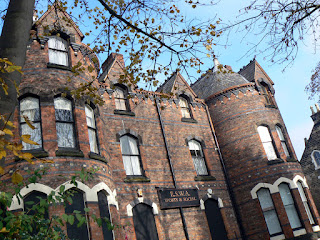
Irvine's former home in Birkenhead.After falling into dereliction it has since been restored and converted into apartments
in 1922 Finch was the chief advocate of oxygen but he was a voice crying in the wilderness; none of the experienced mountaineers wanted to go with him but Geoffrey Bruce did not mind because he was a mountaineer and was game for adventure. secondly, there was an undoubted influence of Everest on expanding the interest in climbing; you might almost say, it was the spark which set the world alight. the selection committee in 1923 were in two minds about including Irvine on the team for 1924. some held the view that he was too young. But Irvine’s supporters had three strong argument in his favour.
First he was a very fine athlete of well proven stamina and splendid strength. Secondly: Noel Odell had been greatly impressed in Spitsbergen (August 1923) with his cheerful devotion to the work of the sledge journey and the dogged determination with which he faced its problems. Odell’s views carried the weight with the pundits in London. Then....and most important of all..Irvine was the right man to be in charge of the oxygen equipment. He was a born engineer and had good workshop experience. he had a keen eye for the solution of practical problems and very skillful hands. None of the others could have done what he did.
The homeland of the Irvine clan in times long past had been in the Scottish lowlands, not far north of the English Border. In the past, one of them had walked south to Liverpool to start a small commercial enterprise. Slowly that business grew. By the time Sandy came on the scene, the family were established in moderate affluence in a nice house in Birkenhead. the sons were sent to Shrewsbury, a school which at the start of the century had on its staff, the best rowing coach in England. When he took up residence in Merton, Oxford in January 1922, Sandy was immediately given a place in the university crew. He was a very fine oarsman indeed.
The speed with which sandy mastered the techniques of racing on skis was to some extent due to his considerable experience of ordinary ski running in Norway and Spitsbergen in 1923. As a mountaineer he was clearly competent above the average for a man of limited experience-the assumption that he had done no previous climbing is quite wrong.
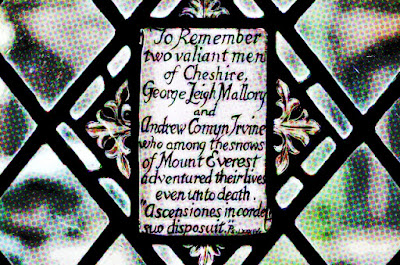
Chester Cathedral Memorial window.Dedicated to its Cheshire born heroes.
At the end of a long life of devotion to the mountains, I look back on so much that has been thrilling and delightful, (though there have been incidents that have given me grief and pain) The days of my active climbing are now long passed. Yet now, in old age, comes a pleasure I never anticipated; the privilege of doing something for the mountain world. For I have revived the memory of an Everester who must not be forgotten. If I may borrow the words from Holy Writ: Andrew Irvine ‘was dead and is alive again; he was lost and is found’.
Herbert Carr: First published in Climber: December 1979

“Thy love of Nature, quiet contemplation,
In meadows where the world was left behind,
Still seeking with a blameless recreation,
In troubled times, to keep a quiet mind;
This, with thy simple utterance, imparts
A pleasure ever new to musing hearts”
Bernard Barton
It is Easter 1982, and I decide that I need to get away for a few weeks climbing as life is beginning to stifle my senses. After some deliberation, I settle on driving to Skye for a return visit but rather than go to the Cuillins to climb, I decide to go to Staffin where I knew there was great potential for much climbing.
Planning takes all of half an hour as I throw everything I think I will need for the fortnight, into the back and boot of the car before leaving home to drive north. The suspension springs are at full stretch and the tyres appear half inflated despite how much air is pumped into them. Turn left at the drive, on through Edinburgh city, bustling with ants hurrying and scurrying about their business, faces set in concrete as they live their lives within a well framed lifestyle of worrying about their mortgage, the cranky boss at work, mundane financial matters, what excuse to use this time for arriving at the office late again, and so on. I drive past without a care in the world knowing that two weeks well-earned holiday on the island of Skye, offers me so much rock to touch and get acquainted with. What a mind blowing thought.
As I drive through Edinburgh, the only two thoughts in my head are, would the trusty old banger make it there, and, would it make the return journey? Nothing else matters, not the weather, not the midges, not even the time of year, April, could dampen my spirits.
After a long but pleasant drive, I arrive at the Kyle of Lochalsh but having missed the last ferry for the night, settle down to sleep in the front seat which was not all that easy given the amount of climbing gear I had thrown on the back seats. I try as best I can to get comfortable in a small space under the steering wheel, but whichever position I get into, the damn thing just sticks out preventing me from doing so. I try sleeping in a sitting position but as the seat would not go back due to the gear stuffed behind it, I just toss and turn, huffing and puffing and moaning to myself as the slow passing of the night crawls agonisingly past.
Dawn finally starts to arrive as I wake from a half sleep, but am dismayed that it is another two hours before the first morning ferry is operational. ‘God I wish they would build a bloody bridge across’ I muse to myself, as I try once again to get comfortable in a space even a contortionist would find difficult. As the full morning sun finally pokes its nose above the murky horizon in a clear blue sky, the sound of the ferry, its diesel engine chugging merrily along, calls out to me: ‘I’m coming, I’m coming, I’m coming’. Eventually it enters the small harbour, and the steel ramp scrapes along the concrete slope as if to say ‘I have arrived’.

At last, I am crossing over the sea to Skye, jubilation, excitement all mixed up with the weariness and aching bones, but at least I was moving. The shore gets closer and so the engine is revved in anticipation which does little to make the last few yards go any faster. Bump, the ferry slides into the far shore ramp and within seconds I am off down the road with the wind at my back.
The ten odd cars that accompanied me across, jockey for first pole position down the narrow road and I am no different. Race after the car in front. Overtake. Get overtaken. Drive faster to overtake the car that has just overtaken me and so the game of leap frog goes on until I get tired of it all and slow down enough to allow them to disappear into the distance, leaving me an empty road. Sods law was only taking a short nap, for when I rounded a sharp bend, there in front was a slow moving lorry.
Braking hard I become frustrated because the road is full of bends for the next few miles or so. A car comes up behind me, close, too close so I tap my brakes to give him a fright hoping that it will make him back off a bit but it doesn’t, it just makes him more determined to overtake me and the lorry at the first opportunity that is presented. Suddenly a straight stretch of road appears and so I signal to pull out, but the car behind has other ideas as he pulls out without signalling and forces his way past me and the lorry waving with two fingers as he passes.
I ignore his gesture and stop at Portree for breakfast before driving on to park in the lay by beside the Old Man of Storr, a magnificent obelisk of rock that stands proud inviting those interested, to come close to its base and admire the conical shape of the rugosities that adorn the surface. Standing around are an array of other odd shaped pinnacles, rugged, weathered and just as magnificent, pleasing to the eye and touch.
I put on my running shoes and with my soft soled climbing shoes slung around my neck, I trot over to the base of the Old Man eager to feel its surface under my fingers.
I remembered that Harold Raeburn a noted Scottish climber and mountaineer visited the Old Man back in 1898 with A. W. Russell who noted at the time, that “we will not venture to assert that the Old Man will never be ascended, but we were quite content to look at him without making an attempt”.
It was not until 1955 when three climbers, that the legendary Don Whillans with George Sutton and John Barber made the first recorded ascent of the Old Man, although it rarely gets repeated ascents due to its suspect rock and the difficulty of finding good protection. However, for the solo climber it is ideal and I was in no mood for thinking otherwise.
As I stand at its base, some 40 feet in diameter, I crane my neck upwards following its shape to the overhanging summit some 160 foot above, being thankful for the light warm breeze that caressed the air making the atmosphere both pleasant and reassuring to me. Donning my climbing shoes, I deliberate on where to start climbing. Should I follow the first ascent line carried out by Whillans, Sutton and Barber assuming I could find it, or should I seek out a route of my own? I chose the latter.
Finding some good hand holds just above head height, I place my right toe gently yet with conviction onto the rock surface and pull up. My fingers are soon playing sweet music on the many protruding rugosities that covered the rock keyboard and my feet dance gracefully to the tune of the tiny holds. Climbing is both ecstatic and friendly in its harmonious contact with me and I truly feel life is indeed, full of bliss and rewards. As soon as my fingers touch the rounded globules and intrusions, my feet follow contentedly, gripping snugly to the same holds that earlier had caressed my fingers.
Movement is ballerina like, tempered with the approach of a fine arts restorer repairing a priceless china vase, delicate, with precision and all with a flowing purpose to please.
My mind is devoid of all thoughts as I allow my senses to become one with the rock itself. Life in every sense of the word, at least right then and there at that moment in time had meaning but impossible to verbally describe. As I move across the angulated rock surface, I sense I was not climbing alone and at one point I was convinced I felt someone’s breath on my naked arms. However, I dismiss this as possibly being a gust of wind until I thought I felt their body touching mine, and so I suddenly stop moving for no apparent reason. I still feel safe so smile contentedly to myself and ‘welcome’ whoever or whatever it was and carry on my ever upwards flowing movement.
Up and up I climb until suddenly I become aware that the holds begin to become intrusive as fingers ache with the roughness of the rock. As I halt my upwards movement, I instinctively look down which is when I realize how far above the ground I am and that a slip would likely result in serious injury or death. In an instant, I relinquish the urge to continue upwards and start to climb back down the odd fifty feet I had gained.
Like Bentley Beetham, I am an ardent advocate of descending a climb, or down climbing as it is often referred to, believing that you should not climb anything you are not prepared to climb down, especially when soloing.
Once back on the ground, I move over to a smaller finger of rock, often referred to as The Old Women, and climb it several times by different routes. Clearly my body is receptive to climbing and so I indulged myself once more back on the Old Man by climbing up and around the circumference in an upwards spiral for approximately sixty feet, then back down using the same strategy.
After playing on some of the other rock pinnacles, I run back down to the car enjoying the tingling sensation in my toes that race upwards flooding all my body senses. I know that the rest of the holiday will be even better.
I had booked a small self-catering cottage in the tiny hamlet of Staffin, but lose no time once I had dumped all my gear inside, to set off to explore the Trotternish peninsula before the sun gave way to the rising moon which had already put in an appearance.

Over the next few days I thrill myself by making acquaintance with many of the odd looking rock pinnacles that surround the upper peninsula area. First there was the Needle, a 100ft pinnacle where I just could not resist the invitation to join the surface all the way to the top. Feeling fit and good with myself, I amble over to the Prison and found an exciting route to the top only to surprise a few local sheep busy munching the sweet green grass that adorn the top ledges. Later, I meet up with the Central Gully to make a hairy ascent inside its dark and dank interior, exiting onto a platform of crumbly schist.
Frank Grant: 2016- Previously unpublished.
Path to Kallas Monastery. (Tibet): Nicholas Roerich 1932
The wise find pleasure in waters, the virtuous in mountains: Kong Zi (Confucius)
The painting of mountains and or climbing action is now an activity with a long history, but it is a difficult discipline to embrace in order to achieve a meaningful result for a studious beholder, and more so for the artist involved. In recent years there has been several such artists within the British climbing world; John Redhead, Tim Pollard, Bill Peascod, Tom Price, Julian Cooper, Jim Curran etc but they were I believe working within a sub section of landscape painting , which has its historical origins in China. A form of art which has always encompassed a spiritual element, drawing on Daoism, but which only became explicit in the west with romanticism.
The earliest landscape painting with no human figures depicted has its origins in frescoes in Minoan Greece, (circa 1500 BCE) but by the 10th/11th century during the Chinese Song dynasty a form of painting, shan shui (mountain water) with brush and ink, had been perfected to the highest standards. Mountains had long been considered sacred places in China, and surprisingly plain dwelling literati painted vertiginous peaks such as Kuo Hsi’s ‘Clearing autumn skies over mountains and valleys’; these works included human figures set in the vastness of nature, with a Daoist emphasis on the insignificance of the human presence in a scene depicting mountains, waterfalls and rivers.
These works (often in scroll form) do not try to represent an exact image of what the painter sees in nature, but what they thought about this. It is not important whether the painted colours or shapes look exactly like the real object; the intent is to capture on paper an awareness of inner reality and wholeness. Shan shui painters use the same materials and techniques as shufu (calligraphy), and they are judged by the same criteria, including a philosophy which regards painting and shufu as a form of meditation, influenced by Chan (Zen) Buddhism.
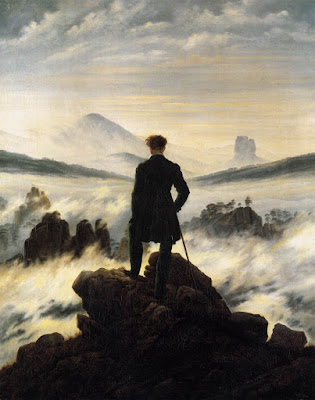
David Friedrich Casper's 'Wanderer above a Sea of Fog'
During the renaissance the development of a thorough system of graphical perspective in Italy, quickly became standard throughout Europe, and later in the USA, and eventually to an ever wider geographic area. This allowed large and complex views to be painted, which had a dramatic effect in the working of outdoor studies. Some of the most outstanding artists of the 18th and 19th centuries painted mountain scenes, and crucial in this development was David Friedrich Casper’s ‘Wanderers Above The Sea of Fog’ of 1818 which had a major influence on the romantic movement, along with Gainsborough’s ‘Mountain Landscape With Shepherd’ of 1783.Subsequently in the US during the 19th century, there was the White Mountain School, which included Albert Bierstadt an outstanding painter of Rocky Mountain Landscapes, and later still from the Hudson River School, Thomas Hill a recorder of views in Yosemite.
By this date mountain studies were appearing as far apart as Duncan Darroch in New Zealand(Mount Cook), Svetlana Kanyo in the Canadian Rockies, Sergio Lopez painting Zion and the Sierras and Ivan Aivazvosky, the Caucasus . Mountain paintings are such that they either compliment ones taste and approval or not, but for myself I have two favourite mountain painters, the English born Edward Theodore Compton (1849-1921) and the Russian, Nicholas Roerich (1874-1947).
I was first intrigued by Compton’s paintings when along with Ian Howell I was invited to give a talk in 1965 at the Alpenverienhaus in Innsbruck about our 1964 attempt on Gauri Sankar. Around the walls of some of the rooms were the most impressive mountain paintings I had then seen. I was even more intrigued about their provenance when I was informed they were the work of an English artist, E. T. Compton.
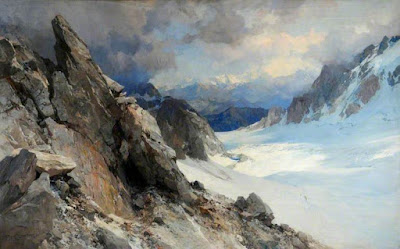
Edward Theodore Compton : Zermatt
Compton I later found out had been born into a devout Quaker family in Stoke Newington in 1849, and exhibited from an early age an outstanding ability at drawing and sketching. His parents recognising his unique talent moved their family to Germany in order for him to study and develop his abilities, first in Darmstadt and then Munich. On a family holiday to the Bernese Oberland, he saw for the first time Alpine mountains and decided he would paint them. It was whilst living in Germany he began to climb, and over the next five decades he made over 300 ascents including 27 firsts, with some of the outstanding mountaineers of that era, Ludwig Purtscheller, Emil Zsigmondy and Karl Blodig. The latter was the first to ascend all the 4000 metre peaks in the Alps, and with whom Compton made the first guideless climb in 1905 of the Aiguille Blanche de Peuterey, and the first ascent of the Torre Di Brenta and the South Face of the Cima di Brenta . In a German publication Berg, he is described as being strong physically, and an excellent technical climber.
Compton became well known as an illustrator for the German and Austrian Alpine Clubs, and was the artist who provided the plates for two of the most iconic mountain books of that period, ‘In the High Mountains’ by Zsigmondy (1889) and ‘Mountaineering in pictures’ by Alfred Steinitzer (1913). In 1880 he was elected to the Royal Academy, and he was a member of the Alpine Club and the DAV (German/Austrian Alpine Clubs). When he was 70 he ascended the Gross Glockner, but his climbing achievements pale once you are confronted by his canvases. For myself, his paintings of the Alps (he also visited North Africa, Scandinavia, the Andes and the UK etc); including the Matterhorn, Mont Blanc, and the Dolomites are memorable but his study of the North Face of the Grandes Jorasses is peerless.
This was exhibited in Chamonix last year, and all those who viewed this (many thousands) were impressed by its detail and accuracy, but nevertheless he can be regarded as an expressionist. He died in 1921 and a hut in the Carinthian Alps bears his name, but his real memorial, are his paintings. It has taken many years for his true technical and artistic ability to be recognised, but if you want to own one you now need deep pockets.
Nicholas Konstantinovich Roerich, little known in Britain, is a man for whom the designation polymath is hardly adequate. There are two museums extant at present which illustrate his achievements as a painter, archaeologist, designer, writer, architect, philosopher, musician, and spiritualist. There is one museum in New York and another in Moscow which aim to illustrate the full range of Roerich’s accomplishments, the most lauded of which are his paintings, particularly of Himalayan Mountains and the peoples of those regions. The totality of his canvases spread amongst different collections around the world amount to a staggering 7000 plus paintings.
He was born in St Petersburg to a well to do notary public, and studied law to please his father and art to please himself; graduating at both the University and the Imperial art school with outstanding grades. An early interest in archaeology and history, caused him to undertake a long journey around Russia and from this, subsequently, once a member of the artistic community in the Russia of that era, he drafted a story, ‘The Rites of Spring’, the music for which was composed by Stravinsky. Diaghilev had been a fellow law student with Roerich, and he invited him to design sets for ‘The Ballet Russes’ which was to cause such a sensation in Paris before the first war. Roerich’s designs for Borodin’s ‘Prince Igor’ (1909) and ‘The Rites of Spring’ cemented his reputation in that field.
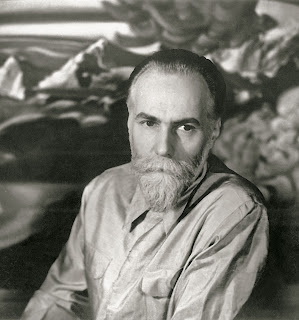
Nicholas Roerich
At the Russian Revolution of 1917, which he supported, along with Maxim Gorky he was trusted with the role of setting up an arts commission by the Soviet, but sickened by the killing and persecutions which followed the revolution, Roerich migrated with his wife and two young boys first to Finland, then to England, invited by Thomas Beecham to design sets for him at Covent Garden. In England he met with H.G.Wells, George Bernard Shaw and Rabindranath Tagore, the Nobel prize- winning Indian poet, whose niece his youngest son Svetoslav married in 1945; the legendary Bollywood actress Devika Rani.
During the first decade of the 1900’s, largely due to his wife Helena, Roerich developed an interest in Eastern religions, which would shape the rest of his life; the influence of Theosophy, Vedanta, Zen Buddhism and other mystical concepts can be detected not only in his paintings, but in the many stories and poems he wrote and illustrated. His wife was related to Mussorgsky, and another connection was with Rimsky-Korsakov, and because of this he was invited to the USA where he designed the sets for that composers opera ‘The Snow Maiden’. They settled in New York and founded there an Institute for the Arts, an art school with an extensive and versatile curriculum, including architecture. Roerich’s acclaimed publication on this subject ’Architectural Studies’ (1904/5) had become a standard text by that date.
They also set up the Agni Yoga Society, whilst -meanwhile an exhibition of his paintings toured the country and a book of his poetry, translated by Mary Siegrist , was published at that time. They stayed in the US until 1923, but then travelled out to Darjeeling, encouraged to move there to be near the Himalaya, which was where they felt their spiritual journey was leading them. Two of his paintings of Kanchenjunga from this date, have subsequently sold at auction for over one million pounds each, I have a framed print of one of these on my living room wall.
This interest in the Himalayan region led on to the Roerich’s setting forth with their son George, a brilliant linguist who was later to publish the first Tibetan/English/Russian language dictionary, and six friends to travel these regions for five years. They started in Sikkim, then moved on to Punjab, Kashmir, Ladakh, the Karakoram, Hotan, Kashgar, Urumqi, Iyrtish, the Altai mountains, the Oyrot region of Mongolia, the central Gobi, Gansu, Tsaidam and finally Tibet. Where they received an icy reception, being stopped on the high Tibetan plateau and forced to live in tents in sub-zero conditions, and to exist on subsistence meagre rations for several months, during which five members of their party died. Finally they were allowed to leave Tibet in March 1928, from whence they retreated back to India.
Returning first to Darjeeling; Roerich wrote several books about his experiences from this incredible journey, much of it on foot, two of which ‘Altai-Himalaya’ and ‘Shambala’ were translated and published in the USA. He had also painted many outstanding studies of the mountains he had viewed, including the Mustagh Tower, whilst traversing the Himalaya. In 1929 Roerich was nominated for the Nobel Peace Prize by the University of Paris. His concern for peace resulted in his creation of the Pax Cultura, the ‘Red Cross’ of art and culture. His work for this cause resulted in the USA and the twenty other nations of the Pan-American Union, signing the Roerich pact on April 15th 1935 at the White House under President Roosevelt. This was an early international instrument attempting to protect cultural property.
Pictures of Roerich at this time, illustrate a tall, bearded, erect personality, who might have emerged out of the pages of a Tolstoy story. In 1935 on behalf of the US Department of Agriculture, accompanied by two of their scientists MacMillan and Stephens, Roerich led an expedition to Inner Mongolia and Manchuria. The expedition’s purpose was to collect the seeds of plants which prevent the destruction of benign layers of soil.
During his journeying in the Himalaya, Roerich decided on the need for a Himalayan Institute and in January 1929, he and his family moved to the Punjab’s, Kulu Valley. A site he had noted on his previous travels, and there by the village of Naggar , he bought the Hall estate from the Rajah of Mandi. His son, Svetoslav who is now revered in India as one of its most famous artists, who studied painting with his father from a young age, declared ‘I have seen many countries, but I have not discovered a more beautiful place as the Kulu Valley’. There they set up the Himalayan Research Institute, ‘Urusvati’ a name which in Sanskrit means ‘The light of the morning star’. From this base they set out on journeys into Lahul, Spiti, and Ladakh , and back at the Institute they studied local cultures, language, the natural sciences and much more.
Both Nicholas and Svetoslav painted local peoples and scenery, whilst their eldest son, George a Philologist, who had studied at University College London, Harvard, and the Sorbonne and was fluent in Sanskrit, Pali, Hindi,Chinese and Tibetan studied local dialects and language. The Roerichs continued their intense work in the Kulu valley until Nicholas died in 1947. Whilst living at Naggar, Roerich was visited by both Nehru and Indira Gandhi and subsequently his son Svetoslav painted their portraits, which along with that of a former President, Radhakrishan, also by him adorn the central Parliament Hall in Delhi.
Nicholas Roerich was a mystic, and an altruistic philosopher dedicated to the Himalaya and its peoples, he painted them as no one else has. He was a symbolist, and prior to his Indian sojourn, many of his paintings are of Slavic history and legend which some find ‘disturbing’. H.P. Lovecraft the cult horror story writer referred several times to the ‘strange and disturbing’ paintings of Nicholas Roerich, especially in his Antarctic novel of 1936,’At the mountains of madness’. Nevertheless one of these ‘strange’ paintings, the Madonna Laboris sold for 12 million dollars at Bonham’s in 2013! So to own one of these you would need even deeper pockets than to purchase a Compton.
There have been so many books now about the Roerich’s that it is hard to understand why so few people have heard about them in the UK? There are several biographies, and one about Nicholas and his wife Helena ‘The Spiritual Journey of two great artists’ by Ruth Drayer was published in 2014, and another ‘Nicholas Roerich- Inspired by the Himalaya’ by Ashok Dilwali appeared in 2013 and several of his own books are still in a revised recently published form. There are even music compositions such as the ‘Roerich Suite’ by Juan Carlos Garcia available as an MP3 download. Besides the two museums dedicated to his works in New York and Moscow, there are Roerich Institutes in Mexico and Brasil.
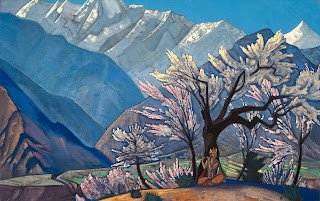
Krishna (Spring in Kulu): Nicholas Roerich
It is obvious now that Roerich was ahead of his time, his spirituality, his interest in Eastern religions and their philosophies detailing a way of living, perhaps anticipated the ‘beat’ movement and its Zen Buddhist* disciples of the 1960’s? But few have been able to bridge the gap in thought and interpretation as he did. He was also such a ferocious worker; to carry on with all the creative activity he undertook year in year out is truly impressive. Inevitably within his huge oeuvre there are works which are sub-standard, especially within some of his writings, but at his best, he was I believe an outstanding artist of the highest ability.
*Zen Buddhism is a fusion of Daoist and Buddhist beliefs. Daoism is the only religion to emerge from China, but Zen is a Chinese construct from the Tang dynasty 618-907), known as Chan in that country, and Zen in Japan and the West.
Dennis Gray: 2016........(Previously unpublished)
Written in 1974, Chris Brasher's article originally published in the BMC's Mountain Life magazine, tapped into the widespread public concern that was being expressed at the time, in relation to a series of mountain tragedies and close shaves involving parties of young people taking part in mountain expeditions organised by schools and outdoor education centres. Hard to imagine now in an age when schools, outdoor centres and those involved in outdoor education have become paranoid about public liability and fear of litigation, back in those far off days,rules and regulations which governed the actions of organisations and individuals taking youngsters on outdoor activity courses, was of course, far more relaxed. 'Abandoning' youngsters in a mountain environment and leaving them to survive and return through their own skills without interference from instructors, was an integral part of a centre's survival and navigation course experiences.
Ironically,the increased regulation and tightening up of outdoor education in the UK has led to massive decrease in the number of youngsters now experiencing outdoor activities. With many LEA outdoor centres since the 1970's now closed down and sold off, and outdoor charities forced to likewise cease their activities, there are many who would argue that the initially well intentioned actions of the state, has had a serious detrimental effect on outdoor education in the UK.
Everyone of us who has ever been in charge of a party of boys or girls on a mountain expedition must fear the thought of the moment when we have to call out the search parties. On Sunday March 17th that moment came to Chris Abel, the master in charge of adventure training at Bredon School, Tewkesbury. The fear is of the hullabaloo that follows every major search for a party of kids — the enquiries by news reporters and television teams, the criticism of other climbers and the tut-tutting of the public. But, that fear can, and must, never interfere with one's responsibility to call for help as soon as it is needed. I myself have known this fear when three different parties of boys were late at their camp site on an exercise that I had set.An exercise which I know now had too many boys in it and was too arduous. Luckily they were all rounded up — after a vast expenditure of my energy — before dark. And I have been on the other end, quizzing masters in charge of parties that have involved massive searches and then writing about it in the press. So now I examine myself before putting pen to paper and I employ one criterion: would publicity help enlighten others and perhaps — just perhaps — help prevent the same sort of thing happening again?
One has to be careful about being too pompous. There is after all no such thing as a safe mountain. With our unpredictable British weather almost any mountain, however apparently welcoming, and at any time of the year, can be dangerous to people without the complete skills and judgement of the mountaineer. So accidents will happen. Having said that, the case of the Bredon schoolboys and Chris Abel, the master in charge, does warrant examination because, in my opinion, there are one or two factors which resemble the case of the massive search for the Hertfordshire schoolboys on the Carneddau last Easter. Bredon School have a cottage called Dorwen (OS sheet 153, G.R. 772 148). On Saturday March 16th, after a morning of instruction in climbing and abseiling, six boys from the school, aged between 13 and 15, set out in two parties of three — one party at 13.50 hrs. and the other at 14.10 hrs. Their route was via the Trig point 1547 and then to Bwlch y Giedd (2,400 feet), on the shoulder of Bannau Brycheiniog, and then by a very steep sheep track (not marked on the map) which leads past the southern end of Lyn y Fan-Fawr to a rendezvous on a minor road at GR 852214 (OS sheet 140). The distance; according to the school, is nine or ten miles and they were supposed to rendezvous with Chris Abel at 17.30 — approximately three and a half hours after they set out.
They carried two emergency rucksacks between the six of them. Each sack contained one tent, one sleeping bag, a plastic bag holding spare clothing, and a one man 24-hour food pack plus one pound of chocolate. Each sack weighed about 24 pounds when dry, perhaps 30 pounds when wet. Each boy had an anorak, a nylon cagoule and corduroy or cavalry-twill trousers. None of them had waterproof trousers and some were without a woollen cap or gloves because the weather was good when they set out. The boys reached the Bwlch at 16.35 hrs by which time, the mist had come down and the wind had risen. In unpleasant conditions -strong wind, cloud and a hint of hail — conditions with which they were not familiar- they could not find the sheep track and rather than face the steep slope down to the llyn they decided to turn back. For some reason (perhaps fear of the steep escarpment on the East) they did not attempt their planned alternative route of coming down the SSE ridge of the mountain (a gentle ridge) until meeting the main road at Gwyn Arms. (This ridge, incidentally, is part of the proposed Cambrian Way)
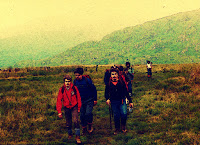
They camped before dark -sunset on that Saturday was just after 18.00 hours- beside a stream at the estimated position 816214. When they did not turn up at the rendezvous point, Mr. Abel and two others started looking for them. Two of the searchers reached the Bwlch at 18.30 and blew their whistles. The boys who were no more than three quarters of a mile away, heard the whistles but the searches did not hear the boys' reply; perhaps because of the wind? Next morning, Sunday March 17th, Chris Abel walked up from Dorwen cottage to Trig point 1547. Visibility was good and the Bwlch was clear. He scanned the whole area with his binoculars and could see no sign of movement. He then went back to the cottage and called out the search teams. That Sunday afternoon more than 100 people searched the area and found nothing. One of the boys was feeling ill and this seems to have spread a certain amount of lethargy amongst the rest of the team. At one time during the day they left their camp standing and went up the Bwlch to try to cross it but were again turned back. They were not found and they settled down to another uncomfortable night, during which there was a slight snowfall.
Next morning, Monday March 18th, they struck camp and set off back to the cottage. They were sighted and rescued by an R.A.F. helicopter at about 0900 hours when they were less than one and a half miles south of their camp site and three and a half miles from the cottage. Chris Abel says that similar parties from the school have regularly done this trip on many occasions before in both directions. Experience, he says, shows that 3-1/2 hours is a reasonable time for it. He himself has been organising this type of expedition for the school for 10 years and before that he was at the Devon Outward Bound School. (Some instructors will no doubt comment that the law of averages had to catch up with him sometimes). He did not set the boys off at an earlier hour because they were involved in climbing and abseiling instruction and because he wanted them to be well briefed and to have a good lunch. The trouble arose, he feels, because one of the party was not feeling well and because the cloud came down half an hour earlier — and it came 1,000 feet lower — than had been forecast.
Now for our comments:
1. The distance by the best route on the map is 8 miles. The height gained is 1700 feet. Two boys out of the six were loaded and the speed of any party is the speed of the slowest. Using the R.A.F. formula for a loaded party of 2-1/2 miles per hour plus one hour for every 1,500 feet gained, the formula time for the expedition is 4 hour 20 minutes. This would put the boys at the rendezvous point at 18.20 hours — after sunset. We realise that formulae are no substitute for experience and Chris Abel has far more experience of this area than we do. Nevertheless, is this not another typical instance of that terrible British habit (of which we ourselves have been guilty many times) of setting out late in the day and not allowing an ample margin of time before dusk. Should not we aim to be at our terminal point by mid-afternoon — or earlier — thus allowing plenty of time for wrong route finding, not feeling well, dawdling over lunch or any of the other diversions that seem to spring up in the hills?
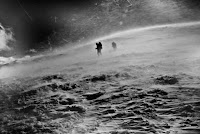
It is worth recalling that the Cairngorm party did not set out until well past mid-day and that the Hertfordshire boys were still at the stream in Cwm Eigiau at 16.00 hours when they were supposed to rendezvous on the summit of Foel Gras at 17.30 hours.
2. Again there is a similarity with the Carneddau incident in that the crux of the Bredon schoolboys' expedition — the crossing of the Bwlch — came near the end of the expedition when there was much less than two hours to darkness. Should not the crux of any "adventure training" expedition come early in the day when the boys are fresh? It then gives them a tremendous glow of achievement to speed their way for the rest of the day.
3. This business of staying put. Many experienced mountaineers felt that all the praise lavished on the Hertfordshire schoolboys (including a Mayoral reception!) for their "sense" in staying put would only lead to other parties of schoolboys bedding down for the night at the first sign of trouble and then waiting to be rescued. If this sounds harsh, then please remember that the Hertfordshire boys were "found" by a couple from Cambridge after they had been "lost" for over 18 hours but they did not want to go down to the Conway Valley with the Cambridge couple because it was in the opposite direction to their rendezvous. And what, may we ask, were the "well- trained" Bredon schoolboys doing throughout Sunday when conditions were such that their master could see the whole route up to the Bwlch.
The pendulum of human experience as tends to swing in an exaggerated way. Before we knew about Mountain Hypothermia, lives were lost because parties and individuals would press on when conditions got bad, the body got wet and exhaustion approached. So out went the call "to stay put and keep warm". And very good advice it is. But it does not mean staying put for two or three nights when conditions are such that escape is more than feasible. Because if this goes on then the fears of those people after the Carneddau incident — fears that our lives would be spent looking for "stay put" parties — may well turn out to be only too true.
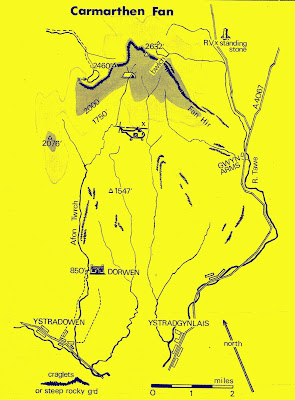
Perhaps it all comes down to this one to truth: that a party is only ‘well-equipped’ in and ‘well-trained’ if it is able to cope with the worst conditions that are liable to be encountered on any expedition. We confess that if that ‘truth’ was always rigidly applied then many famous climbs, many famous expeditions, would never have taken place. But we put it to all our readers that there is a world of difference between an expedition undertaken by — as the phrase goes — ‘consenting adults’ and those set by a school, education authority or outdoor pursuits centre when those in charge are "in loco parentis" to the boys or girls who are setting out on the expedition. Chris Brasher: Mountain Life-April/May 1974
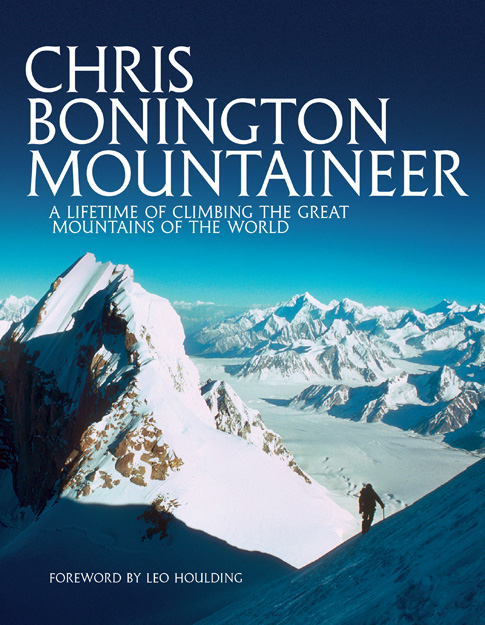
First published in by Diadem in 1989 and edited by the late Ken Wilson, Chris Bonington-Mountaineer, charted the remarkable climbing career of someone,who even 30 years ago, was THE public face of British mountaineering. Since then, his fame and influence has only continued to grow to the extent that the genial knight of the realm is recognised and respected wherever people climb mountains. Chris Bonington Mountaineer originally set out to detail through words and images, his outdoor life, from youthful early days wandering in Somerset’s Quantock hills, to later military style expeditions in the Greater Ranges, where his organisational skills came into their own.
The book was no searing, in depth autobiography but a simple coffee table tome which set out to record his global and domestic campaigns in a photo-journalistic style. The substance and strength of the book was in its photographs with the matter of fact text simply outlining what was going on at the time when the image was recorded. Fast forward almost 30 years and the fifty something action man has become an 80 something grizzled veteran and survivor. Where many have fallen, Chris has overcome triumph and tragedy and remained in the saddle to reach an age when many of his generation who have come this far, have fallen into decrepitude. By contrast, ‘rage,raging against the dying of the light’, he remains ever the activist. Climbing The Old Man of Hoy with young whippersnapper, Leo Holding in his 80th year! Good fortune or simply living a healthy life? Whatever the reasons for his continued rude health, his exploits in the great outdoors continue to delight and astound the mountain community.
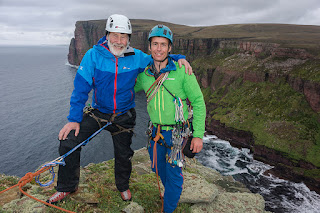
Atop the Old Man of Hoy with Leo Holding:Photo Berghaus
Vertebrate’s 2016 re-issue takes to story forward to the present day. Still chock full of those classic early photographs of people and places,including iconic figure like Don Whillans and Nick Escourt, his post 89 adventures have been brought in to bring his mountain life up to date. Further expeditions to the greater ranges of course, but also recent excursions in Morocco, The USA and Greenland with lifelong friends. Climbing simply for the sheer pleasure of it rather than as part of a sponsored siege of an unclimbed peak.
Given the quality of the images-and not all photographs included were taken by Chris- those interested in photography would be interested to discover what cameras were used to record what are overwhelmingly, outstanding images. Well, Chris is very much an Olympus man. In the footnotes at the back of the book he tells us that he switched to Olympus in 1974 and never changed. Attracted by the introduction of the compact SLR, he generally used Olympus cameras and lenses with Kodachrome film-25/64 above the snowline and 200 below. The Olympus addiction continued into the digital age and he continues to use the OM-D and four third system Pens. Although he confesses to increasingly use an iPhone 6 to record his adventures.
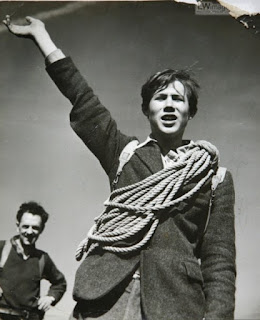
Go North Young Man:
Chris Bonington Mountaineer is out on the 7th November and available direct from Vertebrate or as they say in the trade- from all good book sellers.
John Appleby:2016

I do believe that areas like the Lleyn could represent a facet that has all but disappeared from British climbing”, Steve “the general” Mayers commenting on the on-sight ethic in the early 90s. Al had said that the crack “looked about severe”, the tide was out and we stood beached between seaweeded rocks, cannon ball shined, wet from the outgoing tide. Having descended via a grass ridge into what was later described as Three Caves Zawn, such were the obvious topographical features undercutting the cliff that towered for fifty metres or so above us. Here then beyond Rhiw's lonely village and its queer crocodilian edge, where Bardsey Sound’s tide race conducts unknown depths with awesome power round the mouth of hell, cutting off main landmass from a small mysterious island bearing its name, where in 1188, Gerald of Wales had noted, lived an order of devout coldei monks (pilgrims, I knew, still journeyed there). We set out to worship at the vertical shrine of our won cult, watching our companion figures morph over far headland as we did so. Pure in line, our route lay in devil disguised disfigurement which, austere in its fractured neutrality soon proved a tortuous path where better judgement on a different day might have countenanced retreat.
Peculiar indeed were the seldom visited regions of unsoundness for which the Lleyn retained a certain infamy amongst rock climbers. Take for instance “Craig Dorys” where Stevie Haston had told a bemused farmer working fields above the cliffs abrupt drop, “Do you realise that the best route in North Wales in on your land”. Perhaps not a consensus view, the route in question “Tonight at Noon” features a severely overhanging crack composed of exfoliating mudstone at a modest E7. Longer expeditions are to be found at what might be described as the begging of the Lleyn on the massive earthenware buttresses of Trwyn y Gorlech and Craig y Llam. On the latter anyone climbing the 600' 'Fantan b' can suck in exposure when hidden jugs above a small roof on crux pitch 5 obligates a pullout waymarked by an unbroken plumbob drop straight back to sea level.
Rock type hereabouts is granodiorite and typified by a compact lichenous nature. It makes runners and belays difficult to arrange without pegs, though it generally provides solid holds. Thus the true heart of multi pitch adventure in its most testing form requires travelling further out down the peninsula’s long arching arm. Only then can one become familiar with the great orange slopes within the vicinity of the lead itself. Cilan. “No one goes too often to totter down the nightmare slopes- recuperative periods to re-temper frayed nerves are of an almost alpine necessity”, Dave Holmes commenting on the Cilan experience after the first ascent of New Moon (a four pitch E5) in 1989 with Ray Kay.

In fact if a mention of Cilan Main did not cause momentary shudder chances are you hadn’t yet experienced the bizarreness it represented, or were trying to forget it, perhaps in general withdrawal from everyday world. Big and serious, Cilan is where grit and shale horizontal bandstakes the eye before craning neck muscles allow a gaze to take in the massive capping black roofs two hundred feet above a tiny beach at the crags undercut base. Ray Kay said “It was as if holds were colour coded there”, red / yellow suspect or snappy; black / red for solid enough, yet even with such discernment, routes might not easily succumb, especially when suspicious holds combined with poor protection induced harrowing paranoia on ground that did not lack technical difficulty.
Indeed finding himself spread-eagled in a bluish black groove on Crow's second pitch, Ray had at one point considered simply jumping off, so untenable had his situation become. John Toombs, ever level headed under pressure, once informed of this strategy, counselled “Wouldn’t do that if I were you, Raymond”. Which then allowed Kay to gather himself and complete the pitch which left a lasting impression on both climbers. A clue as to what such an excursion might be like can be found in Crow’s description where on the introductory pitch it reads: “Go round the bulges on handfuls of slate”.
First climbed in 1971, remarkably with only one aide point, by Keith Myhill, Crow attacks the wall to the left of its perhaps more well-known neighbour, Vulture and received a free ascent in 1978 from Mick Fowler and Mick Morrison, one of the very few teams to seek out the Cilan atmosphere at this time.

Mostly the work of Jack Street and Chris Jackson circa late 60s, Cilan consciousness in the form of routes like Central Pillar (a HVS with a difference), that along with Gangway no longer exists in original form, gradually confronted the handful of climbers that went to repeat them with a growing respect, “these routes on the cliffs of the Lleyn Peninsula are perhaps the loosest and most serious yet discovered in Wales”.
World Climbing, 1980
By the late 80s and into the early 90s the roll call of climbers making exploratory routes or repeats began to increase and whist the Peninsula did not experience a trendy ‘place to be’ scenario a few Llanberis based teams initially spearheaded by Ray Kay and Dave ‘skinny’ Jones in the company of John Toombes and Lee McGinley did much to arouse a curiosity in other that would increase the Lleyn resume. Pat Littlejohn with various partners had also been quietly operating in the area for some time and thus with a Culm Coast seal of approval it was clear that those entering this lonely realm would be ill advised to do so without a certain apprehension. Sparsely documented, there seemed a magnetic charm purveyed by the only guide book, a slim off yellow paperback, published by the Climbers Club in 1979 and compiled by Trevor Jones, who after editing known information into forty eight pages reminded would be acolytes that “the descriptions and in particular the grades should therefore be considered as provisional and treated with some respect”. It was good advice.
After using this tome on a number of bitter sweet occasions, we had found a number of zawns apparently untouched by previous explorers. To reach these there were a times difficult sea level traverses and unfeasibly treacherous fishermen’s paths. It was in one of these arenas that I now confronted the so called ‘severe’ looking crack in the zawn of the three caves. 'Bytilith' it was marked on OS maps, yet a most defining feature signing our approach centred on a defunct pipeline emanating from a short red brick wall atop and left of the cliffs when looking out to sea. This forgotten edifice plunged in decay down a disturbing couloir for over a hundred feet ending its fall on beach boulders, from where at low tide it was also possible to get round in to the semi cauldron zawn in which rested out point of interest, a crack line whose apparent ascetic charm was difficult to ignore.
Anyone venturing out on short climbs offered by the ‘grit stone’ edge at Rhiw might be forgiven for thinking that sea cliffs in the vicinity might display a similar, generally solid, nature. Yet, this form of false consciousness, would be, above all hope, swiftly be annulled unless concentrating solely on sea rumbled boulders. Thus the crack once engaged rendered a gear shift on my part so that the mind, hit with information, after architecture each side of the alarming fissure which saw designated footholds explode or de-laminate when nominally weighted, returned to Cilan mode. I think therefore I jamb, or, in a less than grand philosophical sense, which might nevertheless have great repercussions on a personal level, I thought how best jambs should be placed. It wasn’t that baffling technical difficulties suddenly caused a long pause in proceedings, but that typically such ascents rely on a slow probing up and down after securing, at least psychologically, any available protection. Of this, deep inside the crack’s mud butter, better crystallised rock gave home to a couple of friend placements and a big sideways hex biting the fracture’s doubtful outer edges backed them up. It was enough.
When leaders hardly move for half an hour, it might be no surprise to hear second shout in encouragement ‘go for it’ which whilst possible galvanising action in sound rock settings with bomber gear the matter in hand was more likely to succumb after a long mental war of attrition and knowing this Al, maintaining a silent vigil shuffled atop the highest boulders as turning tide began cutting off escape. Cruel were the impediments barring way to the imagined haven promised by a beckoning ledge where steepness was temporarily postponed. This was the belay out sloper, proportioned with a horizontal crumble line taking a friend and some nuts on which I overkilled the snug and braced to bring up the Ruper. A shipwrecked monk lamenting the stone boat’s sinking, no longer paying out.
Crouching and lashed in, maybe eighty feet from where the rock ended at the cave lips and their hollows underneath blew out wave wash over and over, the situation was dramatic. A grey rock pillar dominating the cliff’s upper reaches resembled in appearance Pembroke limestone yet its nature would probably diverge considerably when tested for the properties which Pems is famously known. To the left, the zawn’s concavity bent it round in windscreen flex where it rubbled in ghoul shapes and deep brown death blocks lurking and hanging like gargantuan bats roosting. It lent together in disturbing bulges threatening to drop. Al toiling with the revelation brought on by the crack’s true gravity at one point implored me to give assistance since a deeply seated friend, now inverted, required in a typical case both hand for trigger release least it ‘walk’ towards loss in the crack’s innards. With great regret it was my solemn duty to inform him that no such assistance could be advanced. I did not like to say it, ‘that the belay might pull’. Yet, not long after this heart breaking news arrived, the friend, aided by a forceful extraction pull, think Popeye opening a can of spinach, and with something like flurry of blows Al soon exchanged jambs at the crack’s finale for a creaking welcome on the shelving perch and we hurriedly plugged in the extra cam shoring up the anchors.
On the lunatic fringe of the next pitch a crack / groove took a rock four, biting in solid first go. Bridge out- lean in- left shouldering and a reach with the right gains faulty finger locks. Moving in reptile shape I make a position under an overlap, where things- as Glenn Robbins was fond of saying, and George Smith would later name his Shale City test piece- were 'getting ugly’. Some wall shadows tell the sun is losing us and I can’t pull over.A man hanging forms the gallows of his own making. This surplomb was half mud, half biscuit, half past dead Whymper.... earth, and stuck below it, excavating fragile layers with one hand sapping, exposure bites as an invisible pig suckles strength away. But here now is the animal in most savage form and with survival its only goal, half standing amidst the left arête’s museum porcelain I commit, chest first, to a gaiter roll mantle and twist body parts over drip fed Hammer House horror, emerging a white faced phantom on the uber steps as uncloaked rock grass becomes airborne, famous amongst the shearwaters.
With our compadres return there are two figures forty feet above peering over and I shout them to fix a rope for the exit shoot at the only conceivable belay, a block diagonally distanced some forty feet away, it would have to do, we have no head torches and the overlord on the incubus steps is waiting. I the kick back before the top it feels like I am tread milling a smashed escalator and with the sky empty of birds I find a grim oasis, but there is no warning and suddenly you’re dead. Double vision? No, blood, only a little, but the hard baked pudding stone had struck me a direct skull hit and its bass rhythm sent a shock wave through the jaw, attempting to dwarf me,stunned, the torso as my knees buckled and I stepped for a moment off the round world’s edge... deaf.

'Relaxing after the climb':Image-Martin Crook
But I am okay apart from rope snag on non-extended runners, causing a final crawling technique which gains relief only after clipping in under the rim on the cold cliff, as Rutger Hauer says ‘not yet, not yet’ clenching his Roy Batty fist. Alive. In sort of muck lined crevasse formed by banks, rabbit warren honey combed, I face out towards the Irish Sea, ready to bring up Al from the cirque of the unclingables, and he comes on like a medieval abbot surveying monastery ruins. Schwarzenegger big in his coat, ‘an insensitive oaf’ a girlfriend once called him, but he picks a way through the Herculean jenga pillars without causing collapse when the merest indelicate touch would have caused regret. With wind blast, hoods go tight on the draw cord and below a crusader zeal fuels the oxygen of escape as he passes over the fairy-tale roof with hands hard grasping. ‘Extremely Severe’, he would later say. But then we are there avoiding the head landers, where there are none except those captured in memory. Burdened only by the hillside’s incline we must set a zig zag course away from the pipe wall and taking a breather, become conscious of the slopers at dusk in the R. S. Thomas necroscope night. Down in the dark zawn.....at the end of Wales.
An account of The First Ascent of Headlander 100 metres XS, April 1992, Martin Crook, Alistair Hughes
Martin Crook: 2016: Previously Unpublished.





































